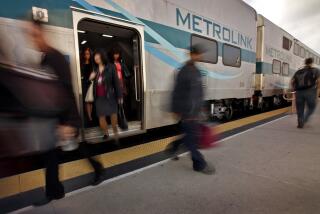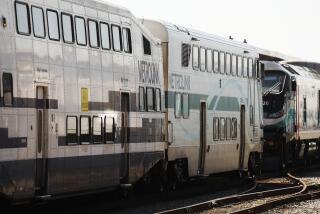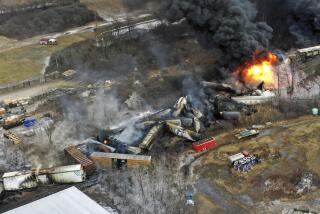Runaway Train Hits 7 Homes; 3 Dead, 10 Hurt
- Share via
SAN BERNARDINO — A runaway freight train careened down the Cajon Pass, leaped the tracks, plunged down a 30-foot embankment and slammed into seven homes Friday morning, killing two boys in one of the houses and a trainman.
One man was missing and 10 were injured, but a man sitting on his couch when the train derailed and flattened his home was miraculously discovered alive beneath 15 feet of rubble more than 13 hours after the crash.
Christopher Shaw, 24, was discovered shortly after 9 p.m. by firefighters using shovels to pick through the ruins of his house. Rescue workers lifted him to safety late Friday night, as onlookers cheered.
Railroad officials said that minutes before the 7:38 a.m. crash, a crewman radioed a “Mayday” call that the heavily laden train was out of control as it began to accelerate down the long 2.2% grade.
All six locomotives and 69 cars of the Southern Pacific freight were hurled from the tracks as the train entered a curve at 90 m.p.h., about three times the normal speed, Southern Pacific officials said.
The wreckage piled up in a grotesque heap of twisted metal that literally flattened two of the homes, including Shaw’s and the one in which the young stepbrothers died.
Hundreds of tons of sand-like sodium carbonate, also known as sal soda, spilled from the hopper cars into yards, houses and streets, burying much of the rubble. Stuffed toys, furniture and kitchen utensils were scattered amid the massive, dune-like heaps of dusty, splintered debris.
Police, firefighters and neighbors clawed through the wreckage to free the injured and take them to nearby hospitals. Paramedics worked with power tools for more than three hours before they were able to free the body of the trainman from the lead locomotive. He was identified as Everett S. Crown, 35, of Bakersfield, the train’s conductor and a 17-year employee of the railroad.
The two dead boys were identified as Jason H. Thompson, 9, and Tyson White, 7.
One missing man was identified as Alan R. Riess, 42, of Bakersfield, a brakeman riding near the front of the train. He was believed still buried in the wreckage.
Presumed Dead
Throughout the day, Shaw was also missing and presumed dead. His home, which he shares with his mother, Maryann, was the most seriously damaged--totally obliterated by several locomotives.
But persistent efforts by specially trained search-and-rescue dogs and workers digging through the rubble paid off.
“I’m glad my son is out of the house,” said a jubilant Maryann Shaw. “It was up to God. I thank God he’s made it.” Despite his ordeal, Christopher Shaw was described as lucid and conversing with firefighters.
Riding with Crown and Riess in the lead locomotives had been the engineer, Frank W. Holland, 33, of Bakersfield, who suffered head injuries, cuts, a broken shoulder and broken ribs in the crash, according to Southern Pacific officials. None of the others injured were identified.
It was not immediately determined what caused the train--bound for Long Beach from Mojave with the load of sal soda that is used in fabric and water softeners--to burst out of control on the long grade down through the San Bernardino Mountains to San Bernardino.
Some officials said the train’s brakes apparently failed, but others said an examination of the wheels showed that the brakes had been applied for at least part of the long ride down.
Railroad officials said three event recorders were on board the train and have not yet been recovered. The devices record crucial data on the train’s operation and actions of its crew.
The train sped for miles down the grade before leaping from the tracks, ripping through some power lines and crashing into the tract of modest, single-story houses in the largely minority neighborhood near Highland Avenue and Duffy Street on the northwest side of San Bernardino.
“I heard a noise that sounded like an earthquake,” said Ruth Green, who has lived on Duffy Street since 1972. “I looked out and I saw that train flying.”
“I knew it wasn’t going to make that curve,” said Walt Greenwood, another Duffy Street resident, whose back fence was crumpled by one of the train’s huge steel wheels. “I grabbed my wife and son and we ran.”
‘It Was Eerie’
San Bernardino Sheriff’s Capt. Ray Harper saw the crash while driving to work on Highland Avenue: “There was a bright blue light, a huge flash as the transformers blew. It was eerie. I thought the thing was coming toward me.”
Diesel fuel leaked from the shattered locomotives and officials, concerned about the threat of fire from the fuel evacuated the neighborhood.
However, the fuel did not ignite and officials said the train was not carrying any toxic material that could have posed a hazard to residents or the environment. Pumps were used to empty the remaining fuel from the tanks of the locomotives.
Two towering cranes were brought in to start moving the wreckage. Officials waited several hours to make sure of the location of an underground jet fuel line before they started using the heavy equipment to dig through the wreckage.
The railroad said it may be weeks before they can clean up enough of the mess to rebuild the torn track and get traffic moving on the heavily traveled line again. On Friday, Southern Pacific rail traffic was rerouted on other tracks, but officials said they plan to construct a temporary bypass around the damaged stretch soon.
The Red Cross set up an emergency shelter near the crash scene, serving coffee and food and providing trauma counseling and cots for victims. School children from the neighborhood spent about three hours at the shelter, but most of the 50 families evacuated were housed by the railroad for the night at hotels in San Bernardino. Officials said those whose homes were not destroyed probably could return to them today.
The National Transportation Safety Board sent a field representative from Los Angeles and a team of experts from its headquarters in Washington to investigate the accident. Railroad officials said they expect the investigation to take weeks.
A team of dogs specially trained to sniff out the dead and injured was flown in from the Bay Area to search for additional victims. The dogs, used previously to hunt for survivors of the 1985 Mexico City earthquake, were provided by the California Rescue Dog Assn.
Use Three Hospitals
The injured were being treated at three hospitals in the area--St. Bernadine’s Hospital and the San Bernardino County Medical Center in San Bernardino and Loma Linda Medical Center in Loma Linda.
Police said several of those hospitalized owed a word of thanks to the neighbors who helped pull them from the wreckage.
Lavene Brewster said her husband, Dudley, was one of those who helped.
“He heard a lady screaming across the street and he ran to rescue her,” Brewster said. “She passed out in his arms. He carried her over to our house.”
Brewster, visibly shaken as she sat with her two young sons at the Red Cross shelter, said the railroad line looming over the homes had always seemed menacing.
“I have worried about those trains for years,” she said. “It’s a nightmare, a nightmare come true.”
Block Devastated
As the daylight faded, the devastated block took on a surreal look, as mangled barbecues, automobiles and patio furniture were bathed in a pink light. Occasionally, a bewildered cat or pet rabbit scampered through the streets, which were thick with the smell of diesel and periodically swirling with clouds of ash.
Times staff writers John Hurst and John Kendall contributed to this story.
More to Read
Sign up for Essential California
The most important California stories and recommendations in your inbox every morning.
You may occasionally receive promotional content from the Los Angeles Times.










